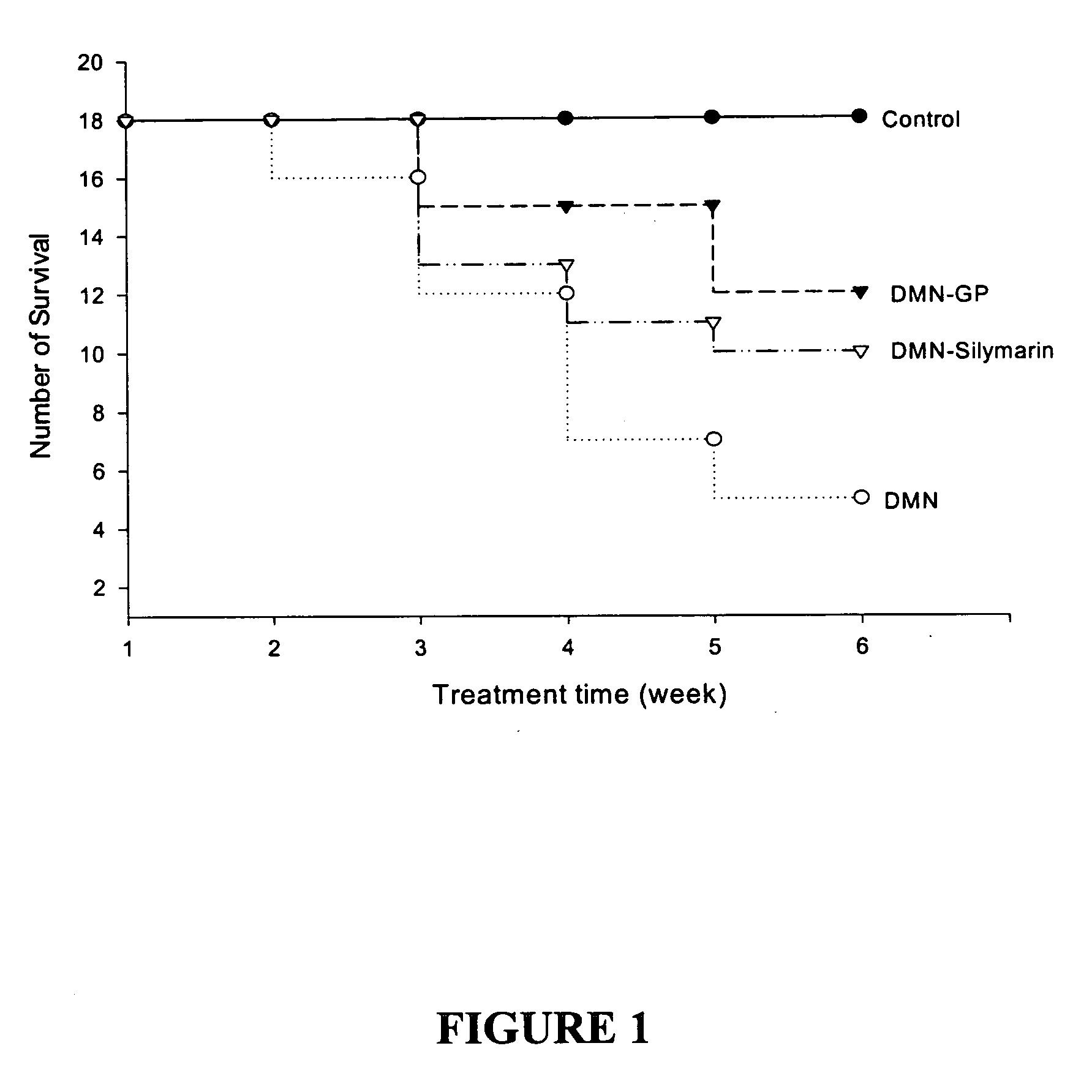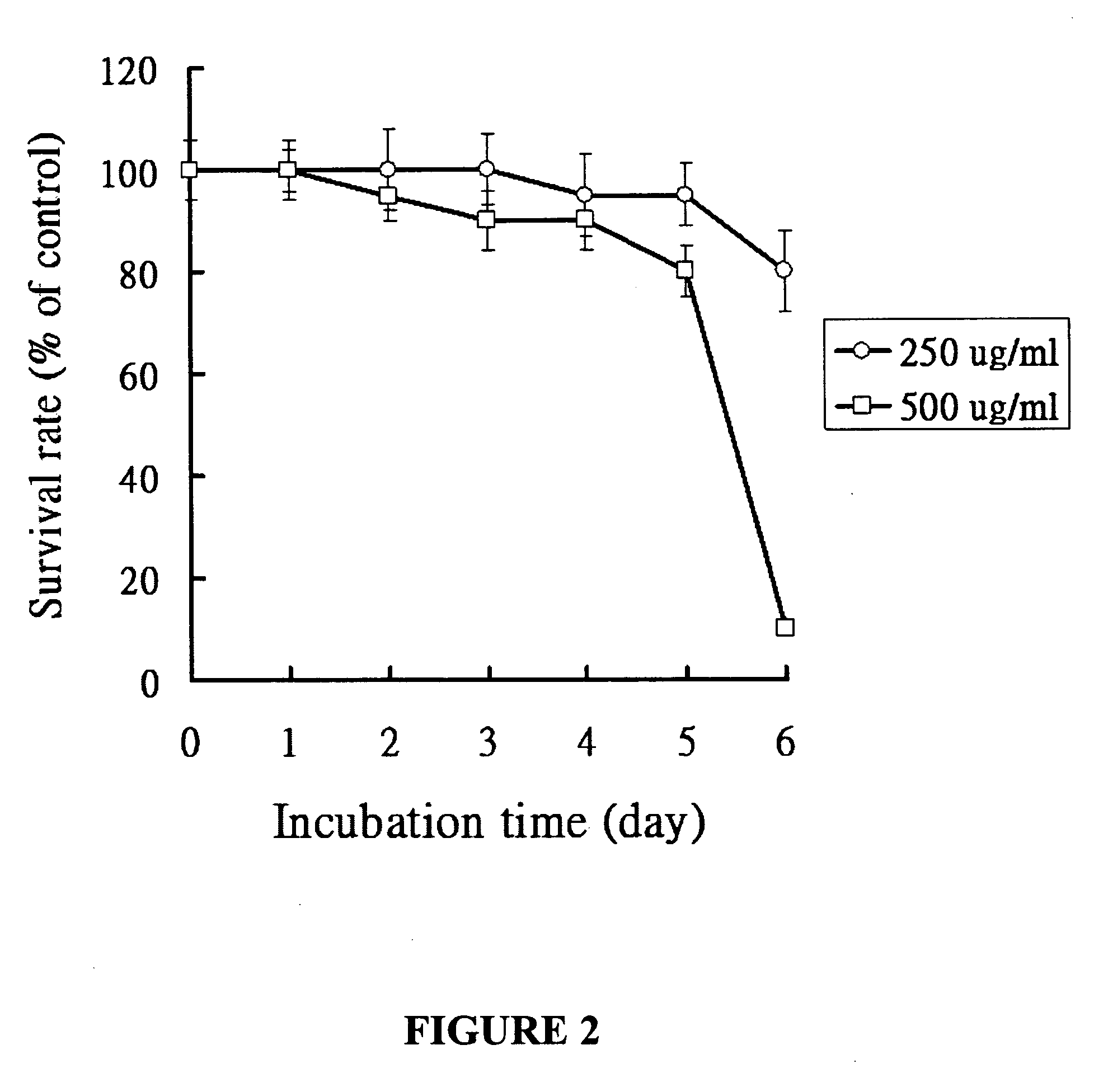Pharmaceutical use of Graptopetalum and related plants
a technology of graptopetalum and related plants, which is applied in the directions of plant/algae/fungi/lichens, biocide, plant compositions, etc., can solve the problems of liver function disruption, necrosis (cell death), liver regeneration, and degeneration, and achieve the effects of improving biochemical markers, reducing the levels of gpt, bilirubin, and gp
- Summary
- Abstract
- Description
- Claims
- Application Information
AI Technical Summary
Benefits of technology
Problems solved by technology
Method used
Image
Examples
example 1
Graptopetalum Prevents Body and Liver Weight Loss Induced by DMN
[0097] To determine the effects of Graptopetalum on liver injury and fibrosis, an animal model was established using DMN, a known toxic substance to the liver. Animals which received DMN, as described in Materials and Methods, were then given Graptopetalum and the effects determined. The effects of Graptopetalum were also compared to those of silymarin, which has known hepatoprotective activities. Normal animals, which did not receive DMN, were used as controls.
[0098] The effects of oral administration of Graptopetalum on body and liver weights of rats with and without i.p. injection of DMN are shown in Table 1. Treatment with DMN caused a significant decrease in rat body and liver weights (DMN-water group) compared with control rats (PBS-water group). Orally fed Graptopetalum markedly prevented this DMN-mediated rat body and liver weight loss (DMN-Graptopetalum group); Graptopetalum also reduced DMN-mediated rat sple...
example 2
Effects of Graptopetalum on Serum Bilirubin, Albumin, Platelets, and Prothrombin Time
[0100] To further investigate the effects of Graptopetalum on liver functions, indicators of liver functions were measured. As shown in Table 2, co-administration of Graptopetalum prevented increases in serum GOT and GPT levels after DMN treatment. Moreover, serum bilirubin levels and prothrombin time increased in DMN-treated rats in comparison to normal controls. However, oral administration of Graptopetalum daily significantly prevented the bilirubin increase and albumin decrease in DMN-treated rats. In addition, treatment with DMN resulted in marked reduction of serum platelets and prolongation of prothrombin time. In contrast, improvement of prothrombin time was significant, and numbers of platelet were consistently higher in the DMN-Graptopetalum-treated groups.
TABLE 2The Level of GOT, GPT, PT, PLT, Bilirubin and Albumin of Serumafter 6 Weeks of TreatmentBilirubinAlbuminGOT (U / L)GPT (U / L)PT ...
example 3
Effects of Graptopetalum on Inflammatory and Necrosis Responses Following DMN Administration
[0102] Since DMN-induced liver injury is considered to be involved in inflammatory responses, we next addressed the question whether Graptopetalum prevents necrosis or inflammatory responses in the liver following DMN intoxication. The results show that massive necrosis in the pericentral and mid-zonal area, with infiltration of inflammatory cells, was observed in the liver three weeks following DMN treatment. Co-administration of Graptopetalum, however, prevented the DMN-induced necrosis and inflammation. Thus, Graptopetalum can drastically prevent necrosis and inflammatory responses in the liver.
PUM
 Login to View More
Login to View More Abstract
Description
Claims
Application Information
 Login to View More
Login to View More - R&D
- Intellectual Property
- Life Sciences
- Materials
- Tech Scout
- Unparalleled Data Quality
- Higher Quality Content
- 60% Fewer Hallucinations
Browse by: Latest US Patents, China's latest patents, Technical Efficacy Thesaurus, Application Domain, Technology Topic, Popular Technical Reports.
© 2025 PatSnap. All rights reserved.Legal|Privacy policy|Modern Slavery Act Transparency Statement|Sitemap|About US| Contact US: help@patsnap.com



